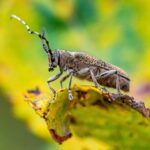Poplar Borer
Bark Beetles & Boring Insects
The Poplar Borer (Saperda calcarata) is a species of clearwing moth in the family Cerambycidae. It is native to North America and is commonly found in deciduous forests, especially in areas where poplar trees are abundant. The adult Poplar Borer is a slender, black-and-brown striped moth with a wingspan of approximately 1.5 inches. The larvae are creamy white and up to 2 inches in length, and they feed on the inner bark and sapwood of poplar trees.
The most noticeable sign of a Poplar Borer infestation is the presence of D-shaped exit holes in the bark of infested trees. These holes are made by the adult moths as they emerge from the bark after pupating. In addition, infested trees often show wilting, yellowing leaves and cankers, and the bark may split open to reveal the tunneling damage done by the larvae.
Poplar Borer damage can be severe and can eventually lead to the death of the tree. To prevent infestations, it's important to plant poplar trees in areas with good air circulation, avoid injuring the bark of the trees, and keep the soil around the trees moist but not waterlogged. Chemical controls are also available, but they are most effective when applied before the larvae begin to tunnel into the tree. In addition, removing dead and dying trees and branches from the area can reduce the risk of Poplar Borer infestations.



